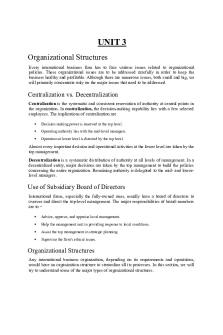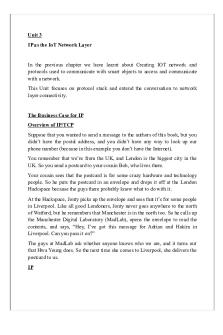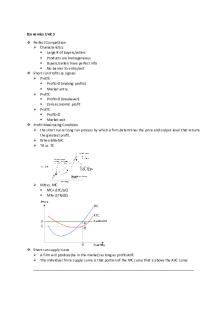Unit 3 Notes PDF

| Title | Unit 3 Notes |
|---|---|
| Author | Cole Bennett |
| Course | Intro Microeconomics |
| Institution | Texas Christian University |
| Pages | 7 |
| File Size | 183.6 KB |
| File Type | |
| Total Downloads | 71 |
| Total Views | 155 |
Summary
Chapter 3 notes...
Description
Economics Unit 3 Perfect Competition Characteristics Large # of buyers/sellers Products are homogeneous Buyers/sellers have perfect info No barrier to entry/exit Short run Profits as signals P>ATC Profit>0 (making profits) Market entry P=ATC Profit=0 (breakeven) Zero economic profit PATC Elasticity and monopolists profits Law of demand Price and Quantity are inversely related TR=P x Q Elasticity= %ΔQ/ %ΔP How to boosts monopolists profit Price discrimination Age Classes Military Students Gender Location Timeframe Matinée movie tickets Conditions necessary for price discrimination Demand curve must be downward sloping Identify and distinguish between people based on willingness to pay Easily and cheaply Prevent resale (arbitrage) Ticket scalpers
Perfect Competition Many buyers/sellers Product homogeneity No barriers to entry
Monopoly No(single seller) N/A Maybe
Monopolistic competition Yes No Maybe
No barriers to exit No economic profit
No(significant to barriers to entry only) Possible economic profit
Social costs of monopoly Quantity goes down and price goes up P>MC Inefficient outcome Guarantee of profit? NO Profit=TR-TC Costs are too high Demand too low(no demand) Monopolistic competition (imperfect competition) Number of firms Large number Small market share that each share makes up Little to no collusion Firms are independent to each other Product differentiation Many close substitutes Monopoly over their own products Some market power Profit maximization MR=MC Tells you the Q* At Q*, what are P* and ATC Tendency towards zero economic profits Starting to look more like perfect competition Advertising TC goes up and TR goes up Hope to increase demand Highlight differentness Patent/trademark/copyright Brand Forms/methods of advertising Who Possibly everyone Focused/more direct target audience What Informational(search) Persuasive(experience) Pros Conveys info; signaling Stimulate competition Cons Overstating the differentness Manipulative Create artificial demand
Yes No economic profit
Could be non-informative
Oligopoly When there is a small number of sellers in a particular market Products are identical or similar Relatively close substitutes There are Barriers to entry Firms are interdependent or strategically dependent Firms are aware of other firms pricing, allocative and productive efficiency Barriers to entry that give rise to oligopoly Legal Economies of scale Mergers Vertical merger-tied to the supply chain (1) Horizontal merger- companies buying out other companies in the same market Reducing the number of sellers Measuring industry concentration Four firm concentration ratio What is the combined market share of the top 4 firms in the industry?(2) Two questions What combined concentration ratio of the top 4 firms constitutes an oligopoly? How to account for the relative share sizes of the top four firms in the market? Herfindahl – Hirschman index(HHI) Sum of the squares of each firms market share Upper and lower bounds Monopoly: HHI=10,00 Duopoly 25/75 split: HHI=6250 50/50 split: HHI=5000 Oligopoly 10 firms @ 10%: HHI=1000 100 firms @ 1%: HHI=100 1000 firms @ .1%: HHI=10 The more firms that share a portion of the market share the lower the HHI will be and will resemble more and more of a monopoly Larger number of firms with smaller the market share = lower HHI Game theory Prisoners dilemma Outcome: both confess “Nash Equilibrium” Where each party has picked a choice given the choices of the other party https://www.khanacademy.org/economics-finance-domain/microeconomics/nashequilibrium-tutorial/nash-eq-tutorial/v/prisoners-dilemma-and-nash-equilibrium Better outcome: both lie If the game is repeated then they would have learned their lesson and be able to get a better outcome
Game Theory: How actors behave in strategic situations(games) Types of games Cooperative vs. Competitive Payoff structures Zero, positive, or negative sum Single vs. repeated Strategy- a decision making rule Dominant strategy- no matter what the players do one person will always “win” Mixed strategy- using the strategy that would be best against the other player’s strategy Response/reaction function (P,Q)=f(P,Q) Ours^ theirs^ Cartels A group of firms colludes and functions as a monopoly Conditions necessary Small number of firms Similar products Easily observable actions Price, quantity, etc. Stability in your market(demand, costs) Major problems Higher prices -> new entrants Cheating Incentive to increase price or quantity
- Productive efficiency occurs when a product is produced using the least-costly combination of resources. This can only be achieved if the producer is producing a level of output that corresponds to their minimum ATC. Under perfect competition, there is a tendency for P = ATC; under the other market structures, we may end up with an outcome where P > ATC, and that ATC is greater than the minimum ATC (the firms experience a mark-up). - Allocative efficiency occurs when a society is producing the 'right' mix of goods and services there is no good or service that is being over- or under-produced. If people desire more of a product, demand will increase, raising price, and attracting more suppliers into the market, which will require the use of more resources. Vice versa if people desire less of the product. As long as the conditions of perfect competition are met (or nearly met), any single market will respond to the changes in consumers' wants, and resources will be re/allocated into the production of the 'right' mix of goods/services....
Similar Free PDFs

Unit 3 Textbook Notes
- 29 Pages

Sdm-unit 3 - notes
- 35 Pages

UE18CS313 UNIT 3 Notes
- 47 Pages

HHD UNIT 3 - notes
- 43 Pages

Unit 3 Notes
- 7 Pages

Unit-3-Notes - Lecture notes 3
- 12 Pages

Unit 3 Study Guide - notes
- 8 Pages

Unit 3 notes - Dr. Drabinski
- 10 Pages

ATAR Notes Unit 3 Summary
- 33 Pages

UNIT 3(VKT) lecture notes
- 15 Pages

PHYS 1000 - Unit 3 Notes
- 7 Pages

Psychology UNIT 3/4 Notes
- 115 Pages

UNIT 3 LEAN Manufacturing NOTES
- 29 Pages

Embedded Systems Notes - Unit - 3
- 11 Pages

Unit-1 - Lecture notes 3
- 39 Pages

VCE Chemistry UNIT 3 NOTES
- 33 Pages
Popular Institutions
- Tinajero National High School - Annex
- Politeknik Caltex Riau
- Yokohama City University
- SGT University
- University of Al-Qadisiyah
- Divine Word College of Vigan
- Techniek College Rotterdam
- Universidade de Santiago
- Universiti Teknologi MARA Cawangan Johor Kampus Pasir Gudang
- Poltekkes Kemenkes Yogyakarta
- Baguio City National High School
- Colegio san marcos
- preparatoria uno
- Centro de Bachillerato Tecnológico Industrial y de Servicios No. 107
- Dalian Maritime University
- Quang Trung Secondary School
- Colegio Tecnológico en Informática
- Corporación Regional de Educación Superior
- Grupo CEDVA
- Dar Al Uloom University
- Centro de Estudios Preuniversitarios de la Universidad Nacional de Ingeniería
- 上智大学
- Aakash International School, Nuna Majara
- San Felipe Neri Catholic School
- Kang Chiao International School - New Taipei City
- Misamis Occidental National High School
- Institución Educativa Escuela Normal Juan Ladrilleros
- Kolehiyo ng Pantukan
- Batanes State College
- Instituto Continental
- Sekolah Menengah Kejuruan Kesehatan Kaltara (Tarakan)
- Colegio de La Inmaculada Concepcion - Cebu